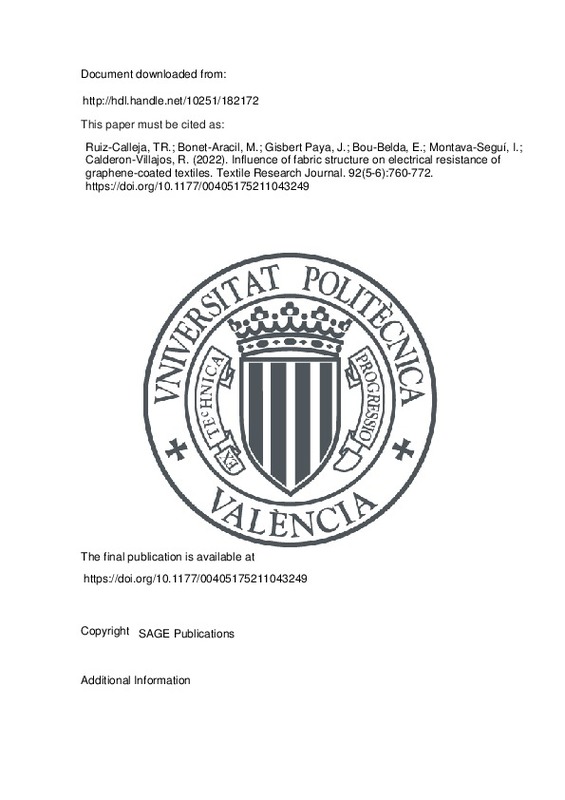JavaScript is disabled for your browser. Some features of this site may not work without it.
Buscar en RiuNet
Listar
Mi cuenta
Estadísticas
Ayuda RiuNet
Admin. UPV
Influence of fabric structure on electrical resistance of graphene-coated textiles
Mostrar el registro sencillo del ítem
Ficheros en el ítem
| dc.contributor.author | Ruiz-Calleja, Tamara Rocío
|
es_ES |
| dc.contributor.author | BONET-ARACIL, MARILÉS
|
es_ES |
| dc.contributor.author | Gisbert Paya, Jaime
|
es_ES |
| dc.contributor.author | Bou-Belda, Eva
|
es_ES |
| dc.contributor.author | Montava-Seguí, Ignacio
|
es_ES |
| dc.contributor.author | Calderon-Villajos, Rocio
|
es_ES |
| dc.date.accessioned | 2022-04-27T09:54:01Z | |
| dc.date.available | 2022-04-27T09:54:01Z | |
| dc.date.issued | 2022-03 | es_ES |
| dc.identifier.issn | 0040-5175 | es_ES |
| dc.identifier.uri | http://hdl.handle.net/10251/182172 | |
| dc.description.abstract | [EN] Coating is a technique widely used in the textile industry for different purposes, mainly in coloring and functional finishes. Graphene is usually applied to fabrics using coating techniques to provide such fabrics with properties like thermal or electrical conductivity. All woven fabrics have peaks and valleys in their structure, generated by the warp and weft threads interlacing. When spreading the graphene coating, the paste is placed in the fabric¿s interstices, and the connection between conductive particles is only produced when the height of the coating is sufficient to connect the different areas where it is deposited. This article analyzes three types of satin weave with three interlacing coefficients (ICs) (0.4, 0.25, 0.17) and two sets of weft yarns each (20 and 71.43 tex). For a blade gap of 1.5 mm, the electrical resistance of samples with weft yarn count of 20 tex and IC of 0.4 is 534.33 X, while for IC ¿ 0.25 electrical resistance is 36.8% higher and for IC ¿ 0.17 this parameter increases 249.3%. For samples with weft yarn count of 71.43, the sample with IC ¿ 0.40 exhibits an electrical resistance of 1053 X, for IC ¿ 0.25 this value rises to 33.9% and for IC ¿ 0.17 the electrical resistance value increases a total of 78.9%. This finding can be of interest for coatings where continuity is crucial, and for the application of substances that need to be protected from external factors, for which fabrics with deep interstices can be designed to house said products. | es_ES |
| dc.language | Inglés | es_ES |
| dc.publisher | SAGE Publications | es_ES |
| dc.relation.ispartof | Textile Research Journal | es_ES |
| dc.rights | Reserva de todos los derechos | es_ES |
| dc.subject | Graphene | es_ES |
| dc.subject | Coating | es_ES |
| dc.subject | Textile | es_ES |
| dc.subject | Conductive | es_ES |
| dc.subject | Weave pattern | es_ES |
| dc.subject | Interlacing coefficient | es_ES |
| dc.subject | Satin weave | es_ES |
| dc.subject | Electrical resistance | es_ES |
| dc.subject.classification | INGENIERIA TEXTIL Y PAPELERA | es_ES |
| dc.title | Influence of fabric structure on electrical resistance of graphene-coated textiles | es_ES |
| dc.type | Artículo | es_ES |
| dc.identifier.doi | 10.1177/00405175211043249 | es_ES |
| dc.rights.accessRights | Abierto | es_ES |
| dc.contributor.affiliation | Universitat Politècnica de València. Departamento de Ingeniería Textil y Papelera - Departament d'Enginyeria Tèxtil i Paperera | es_ES |
| dc.description.bibliographicCitation | Ruiz-Calleja, TR.; Bonet-Aracil, M.; Gisbert Paya, J.; Bou-Belda, E.; Montava-Seguí, I.; Calderon-Villajos, R. (2022). Influence of fabric structure on electrical resistance of graphene-coated textiles. Textile Research Journal. 92(5-6):760-772. https://doi.org/10.1177/00405175211043249 | es_ES |
| dc.description.accrualMethod | S | es_ES |
| dc.relation.publisherversion | https://doi.org/10.1177/00405175211043249 | es_ES |
| dc.description.upvformatpinicio | 760 | es_ES |
| dc.description.upvformatpfin | 772 | es_ES |
| dc.type.version | info:eu-repo/semantics/publishedVersion | es_ES |
| dc.description.volume | 92 | es_ES |
| dc.description.issue | 5-6 | es_ES |
| dc.relation.pasarela | S\445150 | es_ES |







![[Cerrado]](/themes/UPV/images/candado.png)

